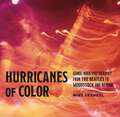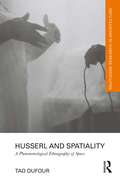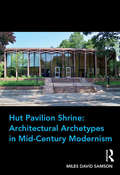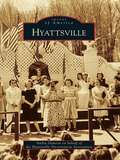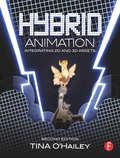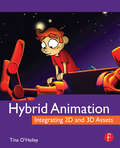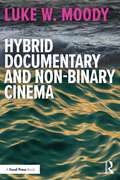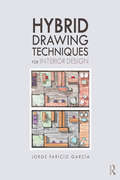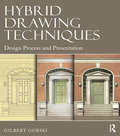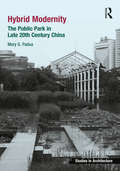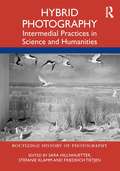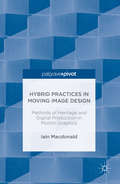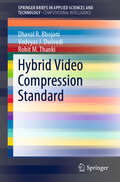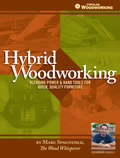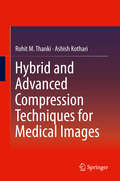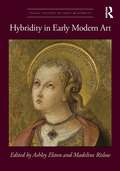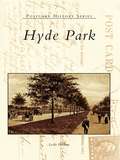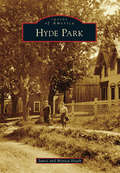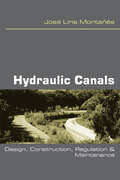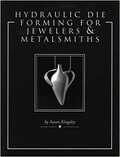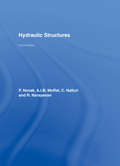- Table View
- List View
Hurricanes of Color: Iconic Rock Photography from the Beatles to Woodstock and Beyond (American Music History)
by Mike FrankelIn 1964, fifteen-year-old Mike Frankel found himself among professional photojournalists covering a Beatles concert during the band’s first tour in the United States. A few years later, he was a regular photographer at the Fillmore East, a storied venue in classic rock. And in 1969, he was onstage at Woodstock, documenting one of the most important events in American music history.Featuring Frankel’s stunning photographs of nearly every major rock figure from the 1960s and ’70s—including Led Zeppelin, Pink Floyd, the Rolling Stones, Janis Joplin, and the Grateful Dead—as well as many unpublished images of the Beatles, Hurricanes of Color chronicles an extraordinary moment. Frankel, who was for a time a personal photographer for Jefferson Airplane and Hot Tuna, developed an innovative style—one that layered images with multiple exposures to capture the spirit of the music of the era and the experience of listening to the bands live.A must-have for fans of classic rock, this is a spectacular and profound collection of photography that complements the music of the world’s biggest performers.
Husserl and Spatiality: A Phenomenological Ethnography of Space (Routledge Research in Architecture)
by Tao DuFourHusserl and Spatiality is an exploration of the phenomenology of space and embodiment, based on the work of Edmund Husserl. Little known in architecture, Husserl’s phenomenology of embodied spatiality established the foundations for the works of later phenomenologists, including Maurice Merleau-Ponty’s well-known phenomenology of perception. Through a detailed study of his posthumously published and unpublished manuscripts on space, DuFour examines the depth and scope of Husserl’s phenomenology of space. The book investigates his analyses of corporeity and the “lived body,” extending to questions of intersubjective, intergenerational, and geo-historical spatial experience, what DuFour terms the “environmentality” of space. Combining in-depth architectural philosophical investigations of spatiality with a rich and intimate ethnography, Husserl and Spatiality speaks to themes in social and cultural anthropology, from a theoretical perspective that addresses spatial practice and experience. Drawing on fieldwork in Brazil, DuFour develops his analyses of Husserl’s phenomenology through spatial accounts of ritual in the Afro-Brazilian religion of Candomblé. The result is a methodological innovation and unique mode of spatial description that DuFour terms a “phenomenological ethnography of space.” The book’s profoundly interdisciplinary approach makes an incisive contribution relevant to academics and students of architecture and architectural theory, anthropology and material culture, and philosophy and environmental aesthetics.
Hut Pavilion Shrine: Architectural Archetypes In Mid-century Modernism
by Miles David SamsonThe phase of American architectural history we call 'mid-century modernism,' 1940-1980, saw the spread of Modern Movement tenets of functionalism, social service and anonymity into mainstream practice. It also saw the spread of their seeming opposites. Temples, arcades, domes, and other traditional types occur in both modernist and traditionalist forms from the 1950s to the 1970s. Hut Pavilion Shrine examines this crossroads of modernism and the archetypal, and critiques its buildings and theory. The book centers on one particularly important and omnipresent type, the pavilion - a type which was the basis of major work by Louis I. Kahn, Paul Rudolph, Philip Johnson, Minoru Yamasaki, and other eminent architects. While focusing primarily on the architecture culture of the United States, it also includes the work of British, European Team X, and Scandinavian designers and writers. Making connections between formal analysis, historical context, and theory, the book continues lines of inquiry which have been pursued by Neil Levine and Anthony Vidler on representation, and by Sarah Goldhagen and Alice Friedman on modernism’s 'forbidden' elements of the honorific and the visually pleasurable. It highlights the significance of 'pavilionizing' mid-century designers such as Victor Lundy, John Johansen, Eero Saarinen, and Edward Durell Stone, and shows how frequently essentialist and traditionalist types appeared in the roadside vernacular of drive-in restaurants, gas stations, furniture and car showrooms, branch banks, and motels. The book ties together the threads in mid-century architectural theory that addressed aspects of type, 'essential' structure, and primal 'humanistic' aspects of environment-making and discusses how these concerns outlived the mid-century moment, and in the designs and writings of Aldo Rossi and others they paved the way for Post-Modernism.
Hyattsville (Images of America)
by Hyattsville Preservation Association Andra DamronHyattsville, Maryland, takes its name from businessman Christopher Clarke Hyatt, who was made the area's first postmaster in January 1859. Hyatt's home and general store were located at the intersection of the Baltimore and Ohio Railroad and the Washington-Baltimore Turnpike, only six miles from the Capitol. Hyatt and other early entrepreneurs transformed the rural countryside, aided by the railroad, into one of the largest communities in Prince George's County by the city's April 1886 incorporation. With its prime location and the advent of the streetcar and automobile, Hyattsville's regional prominence was insured. Today the city's history is reflected by its 1,000-building historic district, which is listed in the National Register of Historic Places. The photographs here, collected from area archives and family memorabilia, depict the life of the community over a 100-year span, including wars, women's suffrage, Prohibition, economic depression, rapid growth, and racial divide. Hyattsville's citizens met these and other challenges with spirit, innovation, perseverance, and tolerance.
Hybrid Animation: Integrating 2D and 3D Assets
by Tina O'HaileyExpand your imagination by letting go of the limitations of traditional animation mediums, software packages, or workflows and integrating 2D and 3D assets. With the updated and expanded second edition of Hybrid Animation you’ll learn how to choose the techniques that best express the artistic and narrative direction of your project and get the technical support you need to bring your ideas to life. Learn how different pipelines of hybrid animation can be broken down and rethought in different packages. Does the 3D character lead a 2D character? Or, does the 2D character have 3D parts? Perhaps a 3D prop is interacting with a 2D character? All of these hybrid patterns are explored from high end to open source software. By the end of the book you’ll be able to see how to apply these techniques to the software you have now. Insight and inspiration are at your fingertips with exercises, step-by-step tutorials and featured interviews with Todd Render of Floyd County Productions and Marty Altman, former CGI Technical Director at Walt Disney Feature Animation. <P><P> Features: <li>Now with updated software methodologies, new tricks, and expanded sections on Toon Boom Animate Pro, Toon Boom Harmony and more. <li>Produce high-quality 2D and 3D narratives in a variety of software workflows, including Photoshop, Corel, Flash, After Effects and Maya, Nuke, Houdini, Smoke, and Toon Boom workflows. <li>Think critically about visual styles, the effects of 2D/3D overlaying and the entire pipeline from start to finish. <li>Explore additional chapters and over 6 gigs of sample files available in the companion data found at www.hybridanimation.com <P><P> Tina O’Hailey is Dean of Digital Media at the Savannah College of Art and Design with locations in: Atlanta, Savannah and Hong Kong. Having worked for Electronic Arts, Walt Disney Feature Animation, she has extensive experience in feature animation and game development. O’Hailey has served as an Artist Development Trainer for Brother Bear (2003), Lilo and Stitch (2003), Mulan (1998) and Prince of Egypt (1998).
Hybrid Animation: Integrating 2d and 3d Assets
by Tina O'HaileyArtist imaginations continue to grow and stretch the boundaries of traditional animation. Successful animators adept and highly skilled in traditional animation mediums are branching out beyond traditional animation workflows and will often use multiple forms of animation in a single project. With the knowledge of 3D and 2D assets and the integration of multiple animation mediums into a single project, animators have a wealth of creative resources available for a project that is not limited to a specific animation medium, software package or workflow processs. Enhance a poignant scene by choosing to animate the scenic background in 2D while the main character is brought to life with 3D techniques. Balance the budget demands of a project by choosing to integrate a 2D or 3D asset to save time and expense. Choose which medium Hybrid Animation, learn the systematic development of the 2D and 3D assets and the issues surrounding choices made during the creative process.
Hybrid Artificial Intelligent Systems: 13th International Conference, HAIS 2018, Oviedo, Spain, June 20-22, 2018, Proceedings (Lecture Notes in Computer Science #10870)
by Álvaro Herrero Héctor Quintián Emilio Corchado Francisco Javier de Cos Juez José Ramón Villar Enrique A. de la Cal José António SáezThis volume constitutes the refereed proceedings of the 13th International Conference on Hybrid Artificial Intelligent Systems, HAIS 2018, held in Oviedo, Spain, in June 2018.The 62 full papers published in this volume were carefully reviewed and selected from 104 submissions. They are organized in the following topical sections: Neurocomputing, fuzzy systems, rough sets, evolutionary algorithms, Agents andMultiagent Systems, and alike.
Hybrid Artificial Intelligent Systems: 16th International Conference, HAIS 2021, Bilbao, Spain, September 22–24, 2021, Proceedings (Lecture Notes in Computer Science #12886)
by Héctor Quintián Emilio Corchado Pablo García Bringas Hugo Sanjurjo González Iker Pastor LópezThis book constitutes the refereed proceedings of the 16th International Conference on Hybrid Artificial Intelligent Systems, HAIS 2021, held in Bilbao, Spain, in September 2021.The 44 full and 11 short papers presented in this book were carefully reviewed and selected from 81 submissions. The papers are grouped into these topics: data mining, knowledge discovery and big data; bio-inspired models and evolutionary computation; learning algorithms; visual analysis and advanced data processing techniques; machine learning applications; hybrid intelligent applications; deep learning applications; and optimization problem applications.
Hybrid Documentary and Non-Binary Cinema
by Luke W. MoodyHybrid Documentary and Non-Binary Cinema offers an expansive exploration of the contemporary documentary cinema form, aesthetics, and ethics.Beginning with an exploration of the parameters and definitions of documentary cinema this book will focus on recent and present‑day examples of work that blur the lines between fiction and non‑fiction. This book will also take a series of case studies to question the vision and motives of filmmakers working between documentary and fictional films. It will consider the aesthetic and ethical challenges of these works and look toward the future of non-fiction filmmaking after the internet, and in the realm of the metaverse. This book will offer both an entry point to discover new tendencies and a deeper understanding for those readers who are more familiar with the field.Given its interdisciplinary subject nature, this book will appeal to audiences across a spectrum of interests such as film, fine art, anthropology, documentary, sociology, and drama.
Hybrid Drawing Techniques for Interior Design
by Jorge Paricio GarciaHybrid Drawing Techniques for Interior Design shows you a flexible and productive design workflow that starts with hand drawing and moves on to digital techniques. In this book, digital and freehand images are displayed side-by-side, so that you can choose at every step which method is best for your desired effect. You will also learn how to draw freehand using a digital tablet, and how to render perspective views, elevations and floor plans. This book includes more than 400 color images and practice exercises that can be referenced online.
Hybrid Drawing Techniques: Design Process and Presentation
by Gilbert GorskiHybrid Drawing Techniques: Design Process and Presentation reaffirms the value of traditional hand drawing in the design process by demonstrating how to integrate it with digital techniques; enhancing and streamlining the investigative process while at the same time yielding superior presentation images. This book is a foundations guide to both approaches: sketching, hardline drawing, perspective drawing, digital applications, and Adobe Photoshop; providing step–by–step demonstrations and examples from a variety of professional and student work for using and combining traditional and digital tools. Also included are sections addressing strategies for using color, composition and light to further enhance one’s drawings. An eResource offers copyright free images for download that includes: tonal patterns, watercolor fields, people, trees, and skies.
Hybrid Machine Intelligence for Medical Image Analysis (Studies in Computational Intelligence #841)
by Kalpana Sharma Siddhartha Bhattacharyya Debanjan Konar Jan Platos Chinmoy KarThe book discusses the impact of machine learning and computational intelligent algorithms on medical image data processing, and introduces the latest trends in machine learning technologies and computational intelligence for intelligent medical image analysis. The topics covered include automated region of interest detection of magnetic resonance images based on center of gravity; brain tumor detection through low-level features detection; automatic MRI image segmentation for brain tumor detection using the multi-level sigmoid activation function; and computer-aided detection of mammographic lesions using convolutional neural networks.
Hybrid Modernity: The Public Park in Late 20th Century China (Ashgate Studies in Architecture)
by Mary G. PaduaThis book provides a detailed historical and design analysis of the development of parks and modern landscape architecture in late 20th century China. It questions whether the fusion of international influences with the local Chinese design vocabulary in late 20th century China has created a distinctive and novel approach to the design of public parks. Hybrid Modernity proposes a new theory for examining the design of public parks built in post-Mao China since the reforms and sets the various processes for China’s late 20th century socio-cultural context. Drawing on modernization theory, research on China’s modernity, local and global cultural trends, it illustrates through a range of case studies ways hybrid modernity defines a new design genre and language for the spatial forms of parks that emerged in China’s secondary cities. Featured case studies include the Living Water Park in Chengdu, Sichuan province, Zhongshan Shipyard Park in Guangdong Province, Jinji Lake Landscape Master Plan in Suzhou, Jiangsu province, and the West Lake Southern Scenic Area Master Plan in Hangzhou, Zhejiang province. This book argues that these forms represent a new stage in China’s history of landscape architecture. The work reveals that as a new profession, landscape architecture has greatly contributed to China’s massive urban experiment. This book is an ideal read for students enrolled in landscape architecture, architecture, fine arts and urban planning programs who are engaged in learning the arts and international design education.
Hybrid Photography: Intermedial Practices in Science and Humanities (Routledge History of Photography)
by Sara Hillnhuetter Stefanie Klamm Friedrich TietjenThis book explores the territories where manual, graphic, photographic, and digital techniques interfere and interlace in sciences and humanities. It operates on the assumption that when photography was introduced, it did not oust other methods of image production but rather became part of ever more specialized and sophisticated technologies of representation. The epistemological break commonly set with the advent of photography since the nineteenth century has probably been triggered by photographic techniques but certainly owes much to the availability of a plethora of hybrid media—media that influence the relation of sciences, humanities, and their methods and subjects. This book will be of interest to scholars in art and visual culture, photography, and history of photography.
Hybrid Practices in Moving Image Design
by Iain MacdonaldThis book, written from the perspective of a designer and educator, brings to the attention of media historians, fellow practitioners and students the innovative practices of leading moving image designers. Moving image design, whether viewed as television and movie title sequences, movie visual effects, animating infographics, branding and advertising, or as an art form, is being increasingly recognised as an important dynamic part of contemporary culture. For many practitioners this has been long overdue. Central to these designers' practice is the hybridisation of digital and heritage methods. Macdonald uses interviews with world-leading motion graphic designers, moving image artists and Oscar nominated visual effects supervisors to examine the hybrid moving image, which re-invigorates both heritage practices and the handmade and analogue crafts. Now is the time to ensure that heritage skills do not atrophy, but that their qualities and provenance are understood as potent components with digital practices in new hybrids.
Hybrid Video Compression Standard (SpringerBriefs in Applied Sciences and Technology)
by Rohit M. Thanki Vedvyas J. Dwivedi Dhaval R. BhojaniThe book presents compression techniques for digital video stream, describing their design using various image transforms, such as discrete cosine transform (DCT), discrete wavelet transform (DWT), and singular value decomposition (SVD). It first discusses the basic requirements and applications of video compression techniques. The book then addresses video compression using DCT as well as the hybrid compression technique, designed and implemented using DCT, DWT and SVD, demonstrating the simulation results for both. Lastly, it proposes future research directions in the field.
Hybrid Woodworking: Blending Power & Hand Tools for Quick, Quality Furniture
by Marc SpagnuoloA faster route to handcrafted results! In the last few years, there's been a push to return to the roots of woodworking when every step was done with hand tools--from resawing lumber and planing it flat, to cutting joins and creating profiles. Working this way can produce beautiful results, but is it the best method for woodworking in the 21st century? In Hybrid Woodworking, author and Internet woodworking star Marc Spagnuolo offers a more efficient approach that combines the strength of power-tool and hand-tool techniques. The end result: You save time and effort while producing furniture that still has that stunning handmade look. The Hybrid System Hybrid Woodworking will show you which machines and power tools are best for the grunt work of furniture making. It will explain which hand tools are essential for fine-tuning. And best of all, it will demonstrate techniques for working flawlessly and efficiently with every machine and tool in your shop. Making beautiful furniture can be immensely gratifying. By adopting the hybrid woodworking system you can get to that satisfying end result with less effort while enjoying every step along the way.
Hybrid and Advanced Compression Techniques for Medical Images
by Rohit M. Thanki Ashish KothariThis book introduces advanced and hybrid compression techniques specifically used for medical images. The book discusses conventional compression and compressive sensing (CS) theory based approaches that are designed and implemented using various image transforms, such as: Discrete Fourier Transform (DFT), Discrete Cosine Transform (DCT), Discrete Wavelet Transform (DWT), and Singular Value Decomposition (SVD) and greedy based recovery algorithm. The authors show how these techniques provide simulation results of various compression techniques for different types of medical images, such as MRI, CT, US, and x-ray images. Future research directions are provided for medical imaging science. The book will be a welcomed reference for engineers, clinicians, and research students working with medical image compression in the biomedical imaging field. Covers various algorithms for data compression and medical image compression;Provides simulation results of compression algorithms for different types of medical images;Provides study of compressive sensing theory for compression of medical images.
Hybridity in Early Modern Art (ISSN)
by Ashley Elston Madeline RislowThis collection of essays explores hybridity in early modern art through two primary lenses: hybrid media and hybrid time. The varied approaches in the volume to theories of hybridity reflect the increased presence in art historical scholarship of interdisciplinary frameworks that extend art historical inquiry beyond the single time or material. The essays engage with what happens when an object is considered beyond the point of origin or as a legend of information, the implications of the juxtaposition of disparate media, how the meaning of an object alters over time, and what the conspicuous use of out-of-date styles means for the patron, artist, and/or viewer. Essays examine both canonical and lesser-known works produced by European artists in Italy, northern Europe, and colonial Peru, ca. 1400–1600. The book will be of interest to art historians, visual culture historians, and early modern historians.
Hybridity in Early Modern Art (Visual Culture in Early Modernity)
by Ashley Elston Madeline RislowThis collection of essays explores hybridity in early modern art through two primary lenses: hybrid media and hybrid time. The varied approaches in the volume to theories of hybridity reflect the increased presence in art historical scholarship of interdisciplinary frameworks that extend art historical inquiry beyond the single time or material. The essays engage with what happens when an object is considered beyond the point of origin or as a legend of information, the implications of the juxtaposition of disparate media, how the meaning of an object alters over time, and what the conspicuous use of out-of-date styles means for the patron, artist, and/or viewer. Essays examine both canonical and lesser-known works produced by European artists in Italy, northern Europe, and colonial Peru, ca. 1400–1600. The book will be of interest to art historians, visual culture historians, and early modern historians.
Hyde Park
by Leslie HudsonFirst founded in 1853 by New York lawyer Paul Cornell, who named the community after the famous London park, Hyde Park was incorporated in 1861 and in 1889 the village was annexed to the City of Chicago. At the time of annexation, Hyde Park was extremely large in size, extending from 39th to 138th Streets. Today the area stretches from Lake Michigan to Cottage Grove Avenue and 47th to 59th Streets.The 1890s was a time of great growth for Hyde Park. The construction of the 1893 World's Columbian Exposition in Jackson Park had a profound and lasting effect not only on Hyde Park and the city, but on the entire country. The famous University of Chicago was founded in 1890 and was under construction simultaneously with the World's Columbian Exposition. The area grew, attracting additional businesses, people, and an expanding economy to the area.
Hyde Park (Images of America)
by Monica Heath James HeathNestled in the quiet hills of Vermont's Green Mountains lies the shire town of Hyde Park. Located in the heart of Lamoille County, its vibrant history reflects the essence of small-town culture, community, and pride. Chartered in 1781 and first settled by John McDaniel in 1787, the town was named after Capt. Jedidiah Hyde, who settled in town with his family from Norwich, Connecticut. One of Vermont's former governors, Carroll S. Page, was an integral part in the town's development in the late 1800s as he was successful in establishing the world's "largest calfskin factory." Surviving the flood of 1927 and the hurricane of 1938, the town in the 1900s experienced growth in business and prosperity. Through vintage photographs of tree-lined streets, mountain views, dairy farms, mills, churches, schools, and the people who bring the very essence of this community to life, Hyde Park celebrates the spirit of this historic town.
Hydraulic Canals: Design, Construction, Regulation and Maintenance
by Jose Liria MontanesAimed at engineers with a good grounding in hydraulic engineering, this practical reference fills a need for a guide to the design, construction, management and modernisation of canals. It provides an in-depth study of the problems caused by seepage, an analysis of the various possible linings, the constraints posed by canals constructed witho
Hydraulic Die Forming for Jewelers and Metalsmiths
by Susan KingsleyHydraulic Die Forming for Jewelers and Metalsmiths was first published in 1993. Many things have changed since then in the world of die forming. The process has become very popular and is no longer considered a threat to traditional metalsmithing methods involving hammers. There are multiple press designs available for purchase and new sources for materials and equipment. A few accessory tools are no longer available, but there are hundreds of new ones that add more versatility to the press. (It's not within the scope of this book to review all the new tools.) <p><p> Lists of jewelry and metalsmithing books, craft organizations, local guilds and other resources have all been updated. In the 2016 Edition, the content and basic design of the book remains the same, offering practical advice on hydraulic equipment, basic information about the materials and processes, and step-by-step directions for making and using dies. The 5th Edition has larger photos, updated illustrations and an enlarged gallery section of work by successful artists.
Hydraulic Structures
by C. Nalluri P. Novak A.I.B. Moffat R. NarayananNow includes Worked Examples for lectutrers in a companion pdf! The fourth edition of this volume presents design principles and practical guidance for key hydraulic structures. Fully revised and updated, this new edition contains enhanced texts and sections on: environmental issues and the World Commission on Dams partially saturated soils, small amenity dams, tailing dams, upstream dam face protection and the rehabilitation of embankment dams RCC dams and the upgrading of masonry and concrete dams flow over stepped spillways and scour in plunge pools cavitation, aeration and vibration of gates risk analysis and contingency planning in dam safety small hydroelectric power development and tidal and wave power wave statistics, pipeline stability, wave–structure interaction and coastal modelling computational models in hydraulic engineering. The book's key topics are explored in two parts - dam engineering and other hydraulic structures – and the text concludes with a chapter on models in hydraulic engineering. Worked numerical examples supplement the main text and extensive lists of references conclude each chapter. Hydraulic Structures provides advanced students with a solid foundation in the subject and is a useful reference source for researchers, designers and other professionals.
